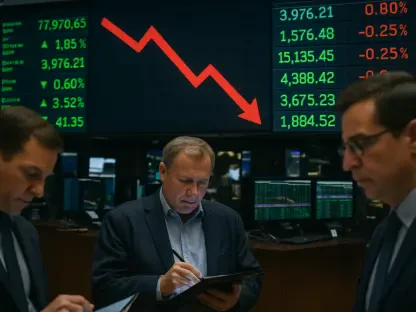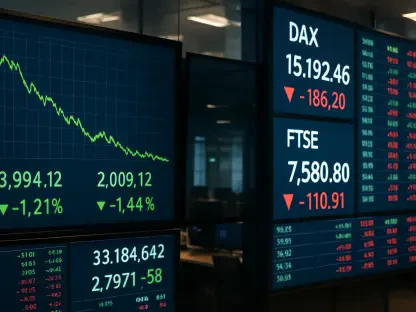As currency markets navigate a landscape fraught with uncertainty, the Japanese yen finds itself grappling with significant depreciation, hovering near a 10-month low against the U.S. dollar, while the greenback surges toward its strongest weekly performance in over a month. This stark contrast paints a vivid picture of global financial dynamics, where economic policies, central bank decisions, and geopolitical tensions collide to shape trader sentiment. The yen’s vulnerability, exacerbated by expansive fiscal measures in Japan, stands in sharp relief against the dollar’s resilience, fueled by ambiguity over Federal Reserve actions. Meanwhile, other major currencies and even cryptocurrencies reflect a broader unease among investors, signaling a risk-averse mood that permeates financial spheres. This intricate interplay of factors underscores a pivotal moment in the currency markets, where each move by policymakers and each piece of economic data can tip the balance, drawing intense scrutiny from traders worldwide.
Policy Pressures Weigh on the Yen
The Japanese yen’s recent slide, trading at 157.41 per dollar after briefly touching a 10-month low of 157.90, highlights deep concerns over Japan’s fiscal health under Prime Minister Sanae Takaichi’s administration. A staggering 21.3 trillion yen ($135.40 billion) stimulus package, recently approved by the cabinet, has sparked fears of ballooning deficits, contributing to a nearly 2% depreciation of the yen over a single week. Such aggressive fiscal expansion, aimed at bolstering economic growth, has instead cast a shadow over the currency’s stability, prompting unease among investors. Japanese officials, including Finance Minister Satsuki Katayama, have voiced readiness to step into the markets to mitigate excessive volatility, echoing actions taken in mid-2024 with a hefty intervention. However, the specter of long-term fiscal imbalance continues to loom large, casting doubt on whether these measures can provide more than a temporary reprieve for the beleaguered currency.
Beyond domestic policy challenges, the yen faces pressure across multiple fronts, weakening against other major currencies like the euro, where it nears record lows at 181.56, and the British pound, hitting a 16-month low of 205.94. Analysts, such as Vishnu Varathan from Mizuho, argue that interventions by Japanese authorities may serve as mere “speed bumps” rather than sustainable solutions to the yen’s decline. This perspective underscores a broader skepticism about the effectiveness of short-term fixes in the face of structural economic issues. The yen’s persistent weakness reflects not only internal policy missteps but also a global environment where risk aversion and divergent monetary strategies amplify currency disparities. As traders remain on high alert for potential government action, the uncertainty surrounding Japan’s fiscal trajectory continues to erode confidence, leaving the yen vulnerable to further depreciation in the near term.
Dollar Strength Amid Fed Uncertainty
On the other side of the currency spectrum, the U.S. dollar is experiencing a robust uptick, with the dollar index climbing to 100.13, marking a weekly gain of over 0.8%. This strength emerges from fading expectations of a Federal Reserve rate cut in the immediate future, driven by a mixed U.S. nonfarm payrolls report for September. While the data revealed accelerated job growth, it also highlighted a concerning rise in the unemployment rate to 4.4%, the highest in four years. Such conflicting signals have muddled the outlook for monetary policy, with market odds for a December rate cut plummeting to just 27%. The ambiguity is further compounded by external pressures, including the risk of a U.S. government shutdown, which adds another layer of uncertainty to the economic landscape. As a result, the dollar has become a safe haven for investors seeking stability amid global volatility.
Economists at Wells Fargo have weighed in on the Fed’s potential next steps, suggesting that a modest 25-basis-point cut could be justified given the economic data, though they acknowledge a pause in rate adjustments is equally plausible. This ongoing debate over the Federal Reserve’s direction continues to underpin the dollar’s resilience, as traders recalibrate their expectations in response to each new piece of information. The greenback’s strength is not merely a reflection of domestic economic indicators but also a reaction to the contrasting monetary and fiscal approaches seen in other economies, such as Japan. With global markets on edge, the dollar’s upward trajectory signals a broader shift toward caution, where investors prioritize stability over risk. This dynamic positions the U.S. currency as a counterpoint to the yen’s struggles, highlighting the divergent paths shaped by central bank policies and economic realities.
Global Currency Volatility and Risk Aversion
Elsewhere in the currency markets, the euro and British pound are grappling with their own challenges, reflecting a pervasive sense of unease among investors. The euro, trading at $1.1537, sits near a two-week low and has declined 0.7% over the week, while the pound, at $1.3087, faces a similar weekly loss of 0.8%. Much of the pound’s vulnerability stems from anticipation surrounding Britain’s upcoming budget, viewed as a critical test for both the currency and bond markets. These declines underscore how domestic policy uncertainties can exacerbate global risk-off sentiment, pushing investors toward safer assets like the U.S. dollar. Meanwhile, the Australian and New Zealand dollars show marginal recoveries, with the Aussie at $0.6446 and the Kiwi at $0.5588, yet they remain under pressure, unable to fully shake off the cautious mood dominating financial markets.
Adding to the narrative of uncertainty, cryptocurrencies such as bitcoin and ether have tumbled to multi-month lows, trading at $85,387.82 and $2,777.39, respectively. Often seen as indicators of broader risk appetite, these digital assets mirror the wariness permeating traditional markets. The synchronized downturn across various asset classes points to a deeper trend of risk aversion, driven by a combination of geopolitical tensions, economic ambiguity, and policy divergences. As major currencies like the euro and pound navigate their own domestic hurdles, the ripple effects of these challenges contribute to a fragmented global financial environment. Traders are left to parse through mixed signals, balancing the allure of safe havens with the potential for unexpected policy shifts, all while the specter of volatility looms large over every transaction.
Reflecting on Market Movements
Looking back, the currency markets revealed a stark dichotomy, with the yen’s sharp depreciation contrasting vividly against the dollar’s notable gains. Japan’s expansive fiscal policies under Prime Minister Takaichi intensified concerns over fiscal health, prompting threats of intervention that offered little long-term reassurance. Simultaneously, the U.S. dollar capitalized on uncertainty surrounding Federal Reserve decisions, bolstered by conflicting economic data that kept traders guessing. Other currencies and digital assets echoed this cautious sentiment, each wrestling with unique domestic pressures. Moving forward, market participants must closely monitor central bank actions and economic indicators for signs of stability or further disruption. A nuanced approach to interpreting policy signals and global trends will be essential in navigating this volatile landscape, as the interplay of fiscal and monetary strategies continues to redefine currency valuations.









